The only way to make sense out of change is to plunge into it, move with it, and join the dance.
-Alan Watts
The temperature has gone back up and Waldo and I are again getting up at 4:30 to beat the heat. The highs are in the eighties, but with the high humidity (in excess of 90%), the temperature index is into the nineties. But it remains in the low seventies when we walk and, aside from sweating a lot, it doesn’t bother us much.
The humidity has been really high this summer, which means it has rained a lot. After all, the more moisture the air holds, the more it can dump out on the ground in a storm. Last year, we didn’t get much precipitation at all and the plants I saw along the trail showed it. Many didn’t grow that high and their leaves were smaller. This year is markedly different. Burdock leaves are huge and there seems to be more of it. Japanese knotweed (a plant originally introduced to the US in the nineteenth century as an ornamental) doesn’t seem to be as prolific and I can see places where it has been supplanted by other species, like orange jewelweed. Maybe the Japanese knotweed doesn’t do so well in wet areas, or maybe the orange jewelweed just does so much better under these conditions. I don’t know, but it’s fun to think about.
There is one species that I haven’t seen before at all – Japanese clover. Like Japanese knotweed, it first appears in the US in the nineteenth century. It’s a “good” plant in that it fixes atmospheric nitrogen (puts the nitrogen in the air into a chemical form that can be used by living things) and helps prevent erosion. I had to stop and pull out my phone to speciate it. It’s probably been there all along, I just didn’t notice it. Now, there are places where it grows in large thick contiguous swathes that I can’t miss and it seems to be taking over where grass once ruled. It’s a plant that grows close to the ground in dense patches. It has smaller leaves than ordinary clover and doesn’t grow as high, nor as scraggly, as grass. My daughter’s yard has never been seeded for grass and grows a number of different kinds of weeds mixed in with the wild species of grass that has managed to take root. This year, the Japanese clover has replaced what was growing there with a soft spongy carpet that I think is better than grassy lawns. My daughter’s front yard is almost all Japanese clover this year. Most people consider it a weed because it chokes out whatever grass they’re trying to grow. Maybe they should consider a change of species. It’s curious, though. Japanese clover is supposed to like poor dry soil, so why is it so prolific this year? Perhaps because of the heat – Japanese clover likes hot places.
Another species that I’ve noticed growing along the trail is liverwort. Liverwort is a lot like moss and likes damp compacted soil where other plants, except moss, can’t take root. Where you find liverwort, you’ll probably also see moss nearby. I’ve seen liverwort around the apartment buildings where I live, but it’s rare. Moss is much more common. Until this year, I’ve only seen it under waterspouts and dripping ACs. This year, though, it’s growing in large thick patches close to the tarmac and under fence rails right next to the rail-trail.
All of this is, of course, lost on Waldo. As I walk along, looking for interesting plants I haven’t paid attention to before, he sniffs away, looking for smells he hasn’t noticed before – and probably some that he has. There’s, of course, the pee-mail, but he also seems to be distracted by odors that don’t seem to be associated by the passage of other dogs. At times, he’ll suddenly, for no apparent reason I can fathom, veer off into the woods, following some scent trail or other. I call him back and he raises his head, as if to say, “Oh, yeah,” and comes back to me. He’s quite patient with me as well. When I stop to look at something, or pull out my phone to take a picture, he stops too. He doesn’t tug at the leash, but just turns his head and looks at me. And waits. Could it be that we’re each doing very similar things, but with different sense organs?
It seems strange that a patch of Mother Earth can be so familiar and yet never cease to hold new stories to tell us every day we’re out here walking. Although, it is true that there is so much here that one can’t hope to take it all in at one time. Not even, it seems, a thousand times. And the constantly changing weather and climate contributes to the variety. You can’t step on the same rail-trail twice – or even once.
It keeps Waldo and me mightily entertained.





